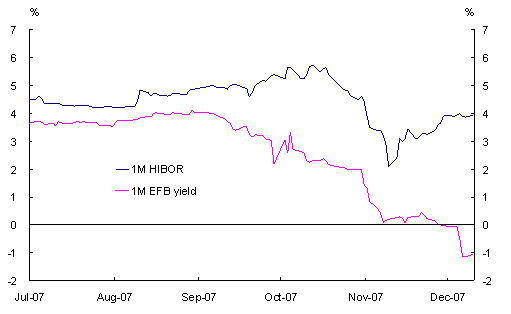Recent movements in the financial markets indicate that there may be a need for additional Exchange Fund paper.
Readers with a continuing interest in the functioning of our financial markets may have noticed a conundrum that has developed in our money market in the past few months – the divergence between the interbank interest rates and the yields of corresponding Exchange Fund paper. The chart attached illustrates this by comparing the one-month HIBOR and the yield of Exchange Fund paper with a remaining maturity of one month. The divergence started some time in August this year, widening from about 60 basis points, which is considered the norm, to about 400 basis points, with the trend intensifying lately. I call this a conundrum because of the lack of clear explanations for it, although a few plausible ones have been put forward, both internally and through our discussions with market participants.
The first reason is the credit concern among banks as a result of the sub-prime crisis in the US. The emergence of the conundrum in August coincides with the large losses incurred by a number of hedge funds that had exposures to sub-prime related securities, the surprise action taken by some financial institutions to restrict redemptions of investment funds because of the drying up of liquidity and therefore the lack of a reliable pricing mechanism for those securities, and the injection of large amounts of liquidity into the interbank market by central banks. The sudden realisation of the uncertain but considerable extent to which the financial positions of leading financial institutions have been affected led to a much more cautious attitude in lending surplus funds in the money markets in Europe and the US.
In Hong Kong this credit concern may have led to banks using their surplus funds to purchase Exchange Fund paper rather than lending them to other banks in the interbank market. This would have explained the divergence between the yields of Exchange Fund paper and the corresponding interbank interest rates. But the divergence was actually quite mild at the beginning. As leading global financial institutions reported disappointing results, large write-offs and substantial re-capitalisation, the concern may have intensified, leading to a much more significant widening of the divergence. Interestingly, while this may be a plausible explanation of the conundrum, it was not the one most commonly put forward by the financial institutions we talked to.
The alternative explanation is one of increasing demand for interbank liquidity to cope with the surge in interbank transactions arising from buoyant primary and secondary stock-market activity in recent months. The turnover of Hong Kong dollar real time gross settlement (RTGS) transactions in the interbank market has been rising, frequently surpassing $1.2 trillion a day in October and November, and reaching a record $1.67 trillion on 5 November. As readers may be aware, the banks hold substantial amounts of Exchange Fund paper for use in the automatic intra-day repurchase arrangement (repo) with the HKMA for intra-day liquidity to settle interbank payments. The volume of intra-day repos of Exchange Fund paper has been on the rise in recent months. Sometimes over 80% of the Exchange Fund paper held by the banks was used for this purpose. It may be that the amount of Exchange Fund paper available to banks, which has been very constant at around $100 billion, to obtain intra-day liquidity has become inadequate to cope with the rapidly increasing interbank transactions.
Interestingly, however, there was, as readers will recall, a very large injection of interbank liquidity in early November as a result of the triggering of the strong-side Convertibility Undertaking, causing the Aggregate Balance to increase from $1.3 billion to $10.6 billion. One would have thought that this would have provided banks with ample liquidity. Quite the contrary: the divergence continued and the gap between one-month HIBOR and yield of the Exchange Fund paper with a remaining maturity of one month increased from 250 to about 400 basis points. It may be that liquidity in the form of Exchange Fund paper is different from liquidity in the form of interbank lending – the former provides banks with liquidity at crucial times during the day, especially in the morning, whereas the latter depends on what time of the day the money is repaid by the borrowing bank.
Whatever the case may be, it seems clear that there is a demand in the banking system for a substantial increase in the amount of Exchange Fund paper. The demand is so great that the Exchange Fund short-term bills now have a negative yield, which means that the banks are even prepared to pay for holding them, instead of just sitting on the money in their clearing accounts. We are actively exploring how an increase in the supply of Exchange Fund paper, consistent with the Currency Board rule of 100% US-dollar backing for the Monetary Base, could be organised to satisfy the demand. Perhaps this will help resolve the conundrum in our money market, although, for as long as credit concerns persist, the gap between HIBOR and the yields of the Exchange Fund paper may continue to be larger than usual.

Joseph Yam
20 December 2007
Click here for previous articles in this column.
Document in Word format


